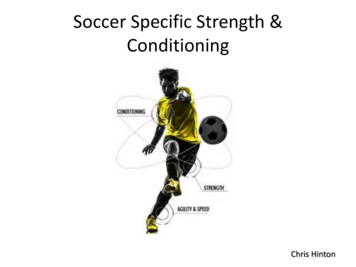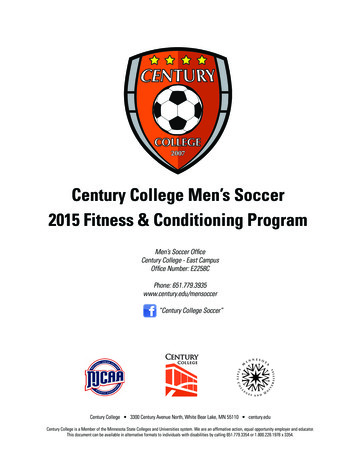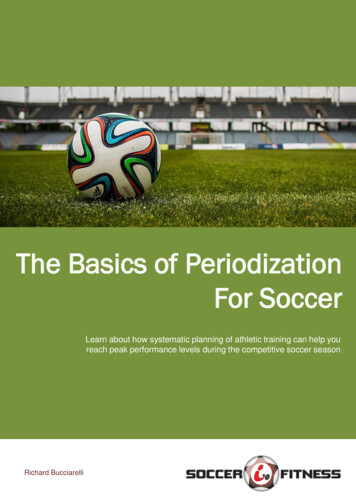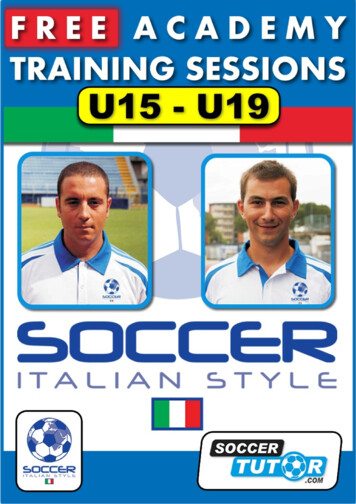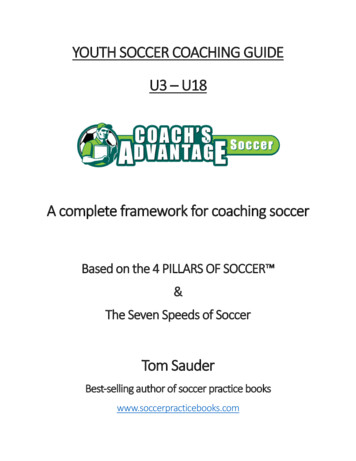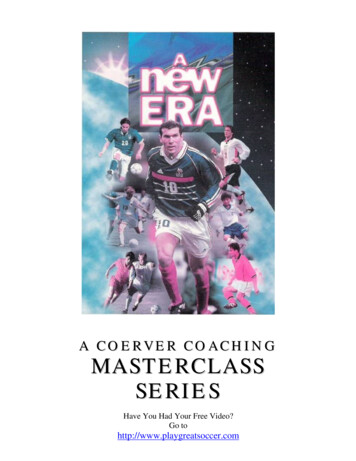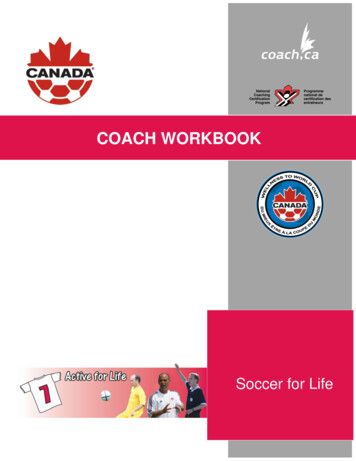
Transcription
COACH WORKBOOKSoccer for Life
Page - 1 -Table of ContentsSoccer for life Course Outline . 2-3Goals of this clinic . . . 4Task 1 - Role of the Coach - What is Soccer? . . . 6Task 2 - Role of the Coach - Knowledge of the players. . . . . 6Task 3 - Role of the Coach – Teaching and organizational skills . . . 7Task 4 - Model Coaching by the Learning Facilitator . 8-10Task 5 - Key factors . . . 11Task 5 - Key elements of a successful field session . 12Task 6 - Planning a Coaching Session . .12Task 7- Practice Coaching Session . . .12Task 8 - Self Coaching assessment . 13LF Mini Lecture on the Principles of the game . . 14Task 9 - Planning a Coaching Session - Attacking/ Defending . .15Task 10 - Practice Coaching Session - Attacking/ Defending . . .16Task 11 - Self Coaching Assessment .16Task 12 - Safety and Liability .17Task 13 - Safety – Emergency Action Plan (EAP) . .18Task 14 - Systems and Styles of Play . 19Task 15 - Model Coaching by the LF - Goalkeeping . .20Task 16 - Model Coaching by the LFFIFA Laws of the game and Set Plays – Attacking & Defending . 20Reference Material . . . .21-34Appendix . . . 35-41Directory of Contacts for the CSA Coach Education Program . . .42-43CANADIAN SOCCER ASSOCIATION l’ASSOCIATION CANADIENNE DE SOCCER
Page - 2 -Soccer for LifeCourse OutlineDay 1HoursLocationContent30 minCourse Registration and Introduction20 minTask 1 - Role of the coach – What is soccer?20 minClassroom20 min60 minField30 minClassroom1 hour20 minClassroomMini Lecture - GAG MethodologyTask 6 - Planning the delivery of a sessionField5 min30 minTask 5 - Key elements of a successful sessionLunch30 min2.5 hoursTask 2 - Role of the coach – Knowledge of theplayersTask 3 - Role of the coach – Teaching &organizational skillsTask 4 - Model coaching by the Learning Facilitator(LF)Task 7 - Practice Coaching sessionTask 8 - Self Coaching AssessmentClassroomLF Mini Lecture on the Principles of the gameCANADIAN SOCCER ASSOCIATION l’ASSOCIATION CANADIENNE DE SOCCER
Page - 3 -Soccer for LifeCourse OutlineDay 2Hours20 min2 x 90 min5 minLocationClassroomContentTask 9 - Planning a Coaching Session – Attacking/DefendingFieldTask 10 - Practice Coaching Session Attacking/Defending PrinciplesFieldTask 11 - Self Coaching Assessment1 hourLunch25 minClassroomTask 12 - Safety and Liability15 minClassroomTask 13 - Safety - Emergency Action Plan (EAP)45 minClassroomTask 14 - Systems and Styles of Play60 minField45 minField10 minClassroomTask 15 - Model Coaching by the LF GoalkeepingTask 16 - Model Coaching by the LF – FIFA Lawsofthe gameandandCourseSet PlaysConclusionEvaluationCANADIAN SOCCER ASSOCIATION l’ASSOCIATION CANADIENNE DE SOCCER
Page - 4 -Goals of this clinicThis clinic has been designed for the community coach in soccer who is working withplayers in the Active For Life stage.The objective is to assist a coach, regardless of prior soccer background, to gain theknowledge required to work with players in order to facilitate their soccer development.The goals of this workshop are to help prepare you to do some of the things that will berequired of you as an Active for Life coach. We will focus on the following: To provide information on Canadian Soccer Association’s Long Term PlayerDevelopment model “Wellness to World Cup” Provide you with some information to help you understand the development stage ofthe children you are working with Consider the safety factors involved in running a session Show you how to manage your sessions using appropriate content Provide you with a resource that you can use to plan your sessions this summer Provide you with advice you can use to work with players and parents in this stageCANADIAN SOCCER ASSOCIATION l’ASSOCIATION CANADIENNE DE SOCCER
Page - 5 COMMUNITY SPORT MODEL: SETTING THE PRACTICE SCENEYou will find the following symbols in this WorkbookThis symbol means referto the Reference MaterialThese symbols mean that youcan refer to the material onthe coach DVD or download itfrom the web siteThis symbol indicates that thenext activity will be on the fieldCANADIAN SOCCER ASSOCIATION l’ASSOCIATION CANADIENNE DE SOCCER
Page - 6 -Task 1 - Role of the Coach (20 min) - What is Soccer?Activity: Sprint of ideasProcess:The LF will give you 2 minutes to list a variety of ways how you can learn the game!The LF will do a mini-lecture for you to get a basic understanding of “What is soccer”Task 2 - Role of the Coach – Knowledge of the players (20 min)Activity: Think and ShareProcess:1. Read pages 24 to 31 in the Reference Material section at the end of thisworkbook. Once you are done, answer the following questions individually:1. What are the development characteristics of players in the early stage of Soccer for Life?2. What are the development characteristics of players in the late stage of Soccer for Life?3. What are the practice recommendations of players in the stage?2. Share your answers with another coach.3. Take the time to add to your answers during or after the discussions anddebrief.Tip:Understanding what motivates children to participate in sport and coaching according tothose motivations will go a long way toward keeping children involved in sport. The truestmeasures of your success as a community coach are the smiles on faces of the children andwhether you are gaining children in your program or losing them. Children get better at asport through practice and encouragement. They will come to practice eagerly if they arefeeling successful and are having fun.CANADIAN SOCCER ASSOCIATION l’ASSOCIATION CANADIENNE DE SOCCER
Page - 7 -Task 3 – Role of the Coach - Teaching and organisational skills( 2 0 m i n)Activity: Jig SawProcess:1.The LF will assign to 3 separate small groups one of the following questions:1.1Before a session: what would I consider1.2Related to the set up1.3Related to my players1.4Related to myself1.2During the practice, what would I consider1.2.1 Related to the set up1.2.2 Related to my players1.2.3 Related to myself1.3After the session, what would I consider1.3.1 Related to the set up1.3.2 Related to my players1.3.3 Related to myself2. Within your small group, come up with a common answer and prepare yourselfindividually to explain this answer to someone else in the class:Our assigned question is3. The LF will now regroup you so that you will find yourself with 2 coaches thathave worked on the 2 other questions. You will each have a chance to presentthe common answer that you have previously prepared with your initial group.4. The LF will now conduct a mini-debrief session on this topic.CANADIAN SOCCER ASSOCIATION l’ASSOCIATION CANADIENNE DE SOCCER
Page - 8 -Task 4 - Model Coaching by the Learning Facilitator (60 min)Activity: Observation and participationProcess:The Learning Facilitator will demonstrate on the field how to coach a S4L session.Make sure to bring a pen/pencil and your workbook with you when you leave theclassroom for the field.1.Individually, take notes on how the facilitator follows the guidelines for: Selecting the ActivitiesOrganizationSafety before and during the sessionDemonstration and ExplanationManner and appearanceNotes:2.Share your answers with another coach.CANADIAN SOCCER ASSOCIATION l’ASSOCIATION CANADIENNE DE SOCCER
Page - 9 PhaseWarm up/AgilityTimeActivity Name10-12 minsBreak2 minsSmall sideGames10 minsBreak2 minsTechnical/TacticalWork15 minsBreak3 minsSmall sidedGames10 minsCool Down5 minsCANADIAN SOCCER ASSOCIATION l’ASSOCIATION CANADIENNE DE SOCCEREmphasis
Page - 10 -Example of a “Soccer For Life” sessionPhaseTimeActivity NameWarm up/AgilityCoaching PointsCarry out the exercises at ajogging pace.Four groups of 3 playersworking in a 25x25m area asshown. Exaggerate the movements.10-12 mins A ball per player. Nine markers breaking the Work in both directions sothat each player gets to workwith both feet.area down into four quarters.BreakSmall Sided2 minGames Open your body to the playTwo teams of 6 including theGKs, plus 1 neutral player. Neutral player always playsfor the team in possession.when receiving a pass. Support in triangles – wide10 mins Playing field of 50x40m. All soccer balls in the goals. Don’t support too close to the Be seen between players2 minTechnical/TacticalHydration/restAccurate passes with good ballspeed.Set-up area 30x15m Open your body to the play Divide players into threewhen receiving a pass.groups of four and positionthem as shown. Central area is a “no goand deep.ball. Remember: distance time. Play starts with the GK.BreakHydration/restAccurate passes with good ballspeed. Support in triangles – wide15 minszone”.and deep. Don’t support too close to theball. Remember: distance time. Play takes place in the endzones only. Teams must switch roles bygoing around coach.Break3 minSmall sided GamesDraw the defender by running athim and get it back behind the defender.Two teams of 5 including theGKs. Playing field of 40x20m. One goal at each end.Hydration/rest Disguise the pass (use outside10 minsof foot, open out and playback inside, etc) Work in triangles with supportplayerCANADIAN SOCCER ASSOCIATION l’ASSOCIATION CANADIENNE DE SOCCER
Page - 11 -Key Factors for Coaching TechniquesThe Soccer for Life Stage:Dribbling:Passing:Heading:Ball close to bodyTarget (awareness)Eyes open and on the ballAttack defender straight-onWatch the ballDirectionTimingPart of the footPart of the headChange of speed/DirectionPart of the ballContact through the ballReceiving theBall:Shooting:Body behind the ballWatch the ballDecision-what next(what/how)Part of the footMove to the ballPart of the ballDirectional touch(cushioned surface)Accuracy before powerSupport:1v1Defending:GroupDefending:Angle of support (behind,in front, to side of ball)Goal side/Ball sideNearest player pressurethe ballOther players support firstdefenderDistance from ballAngle of approachTiming of movementCommunication (Verbal &Body Language)Tight and Loose MarkingSpeed of approachCompactnessCANADIAN SOCCER ASSOCIATION l’ASSOCIATION CANADIENNE DE SOCCER
Page - 12 -Task 5 – Key elements of a successful field session (30 Min)Activity: Small group Poster PresentationProcess:1. The LF will now divide you in 4 groups. Each groups will be assigned one of these4 questions:1.2.3.4.What field equipment is required to run the session and what would you use it for?When teaching a new skill, I need to consider:When deciding on a teaching style to use in a given situation, I need to consider:What is meant by the term “game based learning” and how would you apply it toyour sessions?2. Once you are set, your group needs to brainstorm on the assigned question andcome up with a common answer. A recorder in your group will then create a giantposter using a flip chart to present it to the other groups afterwards. (10 min)3. After 10 min of preparing your poster, a designated presenter will go around theother groups and present to them the answers you have agreed on. All presenterswill rotate to one small group at a time. (15 min)4. You may take personal notes on each of the questions during the different posterpresentations.What field equipment is required to run the session and what would you use it for?When teaching a new skill, I need to consider:When deciding on a teaching style to use in a given situation, I need to consider:What is meant by the term “game based learning” and how would you apply it toyour sessions?The LF will conduct a mini-lecture on the principles of what we call the GAG SessionStructure. (20 min)CANADIAN SOCCER ASSOCIATION l’ASSOCIATION CANADIENNE DE SOCCER
Page - 13 -Task 6 – Planning a Coaching Session (30 min)Activity: Small group workProcess: The LF will divide the class into small groups of 3.Using the practice plan template provided on page 9 of this workbook, your grouphas to design on a flip chart a session that would be appropriate to the needs ofyour players. Select the exercise based on the growth and development of theplayers. (you can find an example of a S4L session on page 10 of this document)You have 30 minutes to design your session. The Facilitator will briefly meet with eachgroup to go over their sessions.Important Notes:Keep in mind that the session you are designing will actually be delivered by themembers of your small group on the field later on. One after the other, you will eachfacilitate one of the activities you have just designed. Once on the field, your group willhave five minutes to set up the group session and each member will have a specificnumber of minutes (determined by the LF) to run a part of the session you havedesigned. At the end of your group session, the LF will debrief your session with theentire class.Task 7 - Practice Coaching Session (2.5 hours)Activity: On field coachingNotes:-After delivering your own activity, take 5 minutes to fill up the “Self CoachingAssessment” below (Task 8).-Once you are done, join the group to serve as a player for the other coaches.Task 8 - Self Coaching Assessment (5 min)1. List 3 things that went well during your delivery:2. List 3 things that you would do differently if you would run this activity again:CANADIAN SOCCER ASSOCIATION l’ASSOCIATION CANADIENNE DE SOCCER
Page - 14 -LF Mini Lecture on the Principles of the game (30 min)Rationale:You have just heard during the LF mini-lecture that coaches should have an understanding of thebasic Principles, which undergird effective team play. These Principles are divided into twocategories; attacking and defending. Applying these Principles appropriately is the bas is oftactical development.Attacking Principles: Dispersal - The location of players in order to stretch and pull defenders out of position.Support - To keep possession we need support in front, to the side & behind the ball.Penetration - Can we score or advance the ball effectivelyMobility - Movement and the interchanging of positions to unbalance defences.Improvisation - Doing the unexpected. Individual football techniques to unlock defencesDefending Principles: Delay - The prevention of forward passing options.Depth/Cover - Closely supporting the 1st defender and the restricting space forattackersCompactness - To assemble as quickly as possible as a team to protect vulnerableareas of the field.Balance – Sealing off the space away from the ball in order to keep the defensivelines compact and limit the opponents attacking options.Control & Restraint (Patience) – Being patient and waiting for the correct momentto attempt to win the ball.Notes for Day 2:Tomorrow morning in class, the LF will form new small groups of 3, will assign you a sessiontemplate and you will prepare for the delivery of a new coaching session on the field, basedon the Principles of Play.End of Day 1 !CANADIAN SOCCER ASSOCIATION l’ASSOCIATION CANADIENNE DE SOCCER
Page - 15 -Task 9 – Planning a Coaching Session – Attacking/ Defending(20 min)Activity: Small group workProcess: The LF will divide the class into new small groups of 3. The LF will assign to your group a pre-design template of a practice plan. Your task is todesign a new practice plan based on a particular principle of Attack/Defence by using thetemplate below. You have 20 minutes to design your session. The Facilitator will briefly meet with eachgroup to go over the task.SSGTech/TacticSSGReminders:Keep in mind that when we go on the field, your group will have five minutes to set upyour session and each member will have a specific number of minutes (determined bythe LF) to run the part of the session you have prepared (activity). At the end of yourgroup session, the LF will debrief with the entire class.CANADIAN SOCCER ASSOCIATION l’ASSOCIATION CANADIENNE DE SOCCER
Page - 16 -Task 10 - Practice Coaching Session – Attacking/Defending(2 x 90 min)Activity: On field coachingProcess:-After delivering your own activity, take 5 minutes to fill up the “Self CoachingAssessment” below.-Once you are done, join the group to serve as a player for the other coaches.Task 11 - Self Coaching Assessment (5 min)1. List 3 things that went well during your delivery:2.List 3 things that you would do differently if you would run this activity again:CANADIAN SOCCER ASSOCIATION l’ASSOCIATION CANADIENNE DE SOCCER
Page - 17 -Task 12 – Safety and Liability (25 Min)In this section, you will have a chance to reflect on how to provide a safe environmentbefore, during, and after practices and games? This will be a good checklist that youcan photocopy and use this season to remind you what to do.Activity:Pair and ShareProcess:Partner with another coach in the room and answer the following 3 questionsbelow.1. What are the potential risks to consider in soccer?2. What would be the strategies for managing these risks?3. What can you do to prevent injuries during the season?CANADIAN SOCCER ASSOCIATION l’ASSOCIATION CANADIENNE DE SOCCER
Page - 18 -Task 13 - Safety – Emergency Action Plan (EAP)- (15 Min)Activity: Think and ShareProcess: Read the following scenario and answer the question below on what you would do:“Assume you are running a practice with your young players. While you’re workingwith a group of players, another one comes to you in a panic and tells you that twoof his/her teammates have just collided and that they knocked their heads togetherhard. One appears to have lost consciousness and seems disoriented.”Write what you would do below, step by step, if you were faced with this situation.Pair and share your answers with another coach.Read pages 32-34 & 41 in the Reference Material at the end of this workbook. The LF will thenconduct a mini-lecture.CANADIAN SOCCER ASSOCIATION l’ASSOCIATION CANADIENNE DE SOCCER
Page - 19 -Task 14 - Systems and Styles of Play (45 min)Activity:Town Hall Poster PresentationProcess:1. The LF will now divide you in 4 groups. Each groups will be assigned one ofthese 4 questions:a. List the different philosophies of play?b. Draw your players on the field and present the different ways to organize your 11players and explain why for each?c. List the game components?d. What are the different moments of the game?2. Once you are set, your group needs to brainstorm on the assigned question andcome up with a common answer. A recorder in your group will then create agiant poster using a flip chart to present it to the other groups afterwards.(15 min)3. After 20 min of preparing your poster, a designated presenter from your groupwill present to the larger group (Town Hall) the answers you have agreed on.(15 min)4. You may take personal notes on each of the questions during the differentposter presentations.A:B:C:D:5. Mini lecture by the LF (15 min).CANADIAN SOCCER ASSOCIATION l’ASSOCIATION CANADIENNE DE SOCCER
Page - 20 -Task 15 - Model Coaching by the LF - Goalkeeping (60 min)Activity: Observation and participationProcess:The Learning Facilitator will demonstrate on the field how to run a goalkeeping session.Make sure to bring a pen/pencil and your workbook with you when you leave the classroomfor the field.1. Individually, take notes on how the facilitator follows the guidelines for: Selecting the Activities Organization Safety before and during the session Demonstration and Explanation Manner and appearanceNotes:Task 16 - Task 16 - Model coaching by the LF –FIFA Laws of the game and Set Plays (45 min)Activity: Observation and participationProcess:The Learning Facilitator will use the small-sided game to teach FIFA laws of the game anddemonstrate on the field how to run a session focusing on “Set Plays”.1. Individually, take notes on how the facilitator follows the guidelines for: When is the ball in and out of play?When can the GK use their hands?What is a foul/stoppage?How is the game restarted?What is offside?Notes:CANADIAN SOCCER ASSOCIATION l’ASSOCIATION CANADIENNE DE SOCCER
Page - 21 -ReferenceMaterialCANADIAN SOCCER ASSOCIATION l’ASSOCIATION CANADIENNE DE SOCCER
Page - 22 -IntroductionThe NCCP vision for children in community sportChildren play a sport in order to have fun and to be with friends. Every child involved in sport should have a positiveexperience, which is only possible when the sport environment is both physically and emotionally safe.The children depend on you, the coach in community sport, to build and maintain the sport environment. Children willbe able to develop a love for sport when your leadership is directed at valuing each and every one of them. You havean important opportunity to have an im- pact on the lives of the children involved in your program.This workshop is intended to support your efforts by providing you the opportunity to learn and improve as a coach.Congratulations on taking the step to participate in this workshop, and thank you for the time that you are giving todevelop sport for children in Canada.A new structure for the NCCPThe NCCP is in the process of changing from its old structure with five levels (1 to 5) and threecomponents (Theory, Technical, and Practical) to a new structure that is based on the threedifferent streams in which coaching takes place in Canada.THE NEW NCCPSTRUCTURECommunity Sport CompetitionInitiationOngoing participation IntroductionDevelopmentHigh performanceInstruction BeginnersIntermediate performersAdvanced performersThe NCCP recognizes community coaches as important leaders in the sport experiences ofCanadian youth. This is reflected in the new structure of the program.For more information on the changes to the NCCP, visit the Coaching Association of Canadawebsite at www.coach.caCANADIAN SOCCER ASSOCIATION l’ASSOCIATION CANADIENNE DE SOCCER
Page - 23 -Long Term Player Development (LTPD)Soccer is the largest participation sport in Canada and the world, providing healthy physicalactivity for players at all levels of ability. In June 2008, the Canadian Soccer Associationlaunched their Long Term Player Plan (LTPD) “Wellness to World Cup”. The seven stagemodel follows the generic Long Term Athlete Development (LTAD) model that has been adoptedmy numerous sports around the world to provide a comprehensive development foundation. LongTerm Player Development (LTPD) is a program of soccer player development, training,competition, and recovery based on biological age (i.e. physical maturity) rather thanchronological age.LTPD is,Player CenteredCoach DrivenAdministration, Sports Science & Sponsor SupportedUnder the CSA’s leadership, LTPD can provide the framework for high quality programs at allstages that ensure enjoyable lifelong playing opportunities for players of all levels of ability, aswell as development pathways for elite players who pursue excellence. The CanadianSoccer Association’s Technical Department is striving to be at the leading edge ofimplementation of the LTPD and has modified the coaching development pathway to reflectthe stages of development of the LTPD.LTPD and Canadian Soccer Association Coaching Pathway – Community StreamCANADIAN SOCCER ASSOCIATION l’ASSOCIATION CANADIENNE DE SOCCER
Page - 24 -STAGE 7: Soccer for Life13 and up Female and Male“SOCCER FOR HEALTH & GRASSROOTS GROWTH”At any stage in the LTPD model, regardless of their level of ability, players may decide toplay soccer as a purely recreational sport so they can continue to enjoy the game andmaintain lifelong wellness. They might be youth players who decide not to pursue highperformance, or they might be top players from senior clubs, colleges, universities, andsemi-professional teams who enjoy competition but do not intend to play at theinternational level. They might also be complete newcomers to the game who discover aninterest in soccer in late adolescence or adult life. Players at all levels should haveopportunities to become active in soccer coaching, officiating and administration. Therecruitment and retention of players, coaches, referees and administrators is key to theongoing development of both grassroots and elite soccer in Canada.Youth PlayersMany youth players pursue the dream of representing Canada; others play for simple enjoyment of thegame, the camaraderie of being on a team, and the health benefits that the sport provides. LTPD seeks toprovide opportunities for youth players to continue in the game, even if they do not pursue highperformance play.Competitive and High-Performance PlayersMany players with senior clubs, colleges, universities and semi-professional teams enjoy competition butdo not intend to play at the international level. Along with thousands of adults playing in variouscompetitive divisions, they deserve opportunities to continue playing at an appropriate level that sustainstheir passion for the beautiful game.NewcomersSoccer attracts newcomers of all ages who want to enjoy a team sport while learning new skills andimproving their health and wellness.Opportunities should exist to encourage these latecomers to learn and play the game, regardless of theirskill level or ability.Player RetentionAfter they retire from playing, soccer players of all abilities (including senior club, high-performance andprofessional) should be encouraged to pursue careers as soccer coaches, mentors, referees,administrators or sport science specialists. Soccer and its governing bodies benefit when players areformally encouraged and retained within the fabric of the game.CANADIAN SOCCER ASSOCIATION l’ASSOCIATION CANADIENNE DE SOCCER
Page - 25 -Player characteristics and training recommendationsCANADIAN SOCCER ASSOCIATION l’ASSOCIATION CANADIENNE DE SOCCER
Page - 26 -CANADIAN SOCCER ASSOCIATION l’ASSOCIATION CANADIENNE DE SOCCER
Page - 27 -CANADIAN SOCCER ASSOCIATION l’ASSOCIATION CANADIENNE DE SOCCER
Page - 28 -CANADIAN SOCCER ASSOCIATION l’ASSOCIATION CANADIENNE DE SOCCER
Page - 29 -CANADIAN SOCCER ASSOCIATION l’ASSOCIATION CANADIENNE DE SOCCER
Page - 30 -CANADIAN SOCCER ASSOCIATION l’ASSOCIATION CANADIENNE DE SOCCER
Page - 31 -CANADIAN SOCCER ASSOCIATION l’ASSOCIATION CANADIENNE DE SOCCER
Page - 32 -Emergency Action PlanAlthough serious injuries or accidents are rare, you must be ready to deal with them if and whenthey occur. As a first step, formal training in first aid and CPR for all team staff will give you theconfidence and knowledge you need to deal with emergencies effectively.You should maintain a complete First Aid Kit to help you deal with minor injuries.Develop an Emergency Action Plan and write it down so everyone involved is clear on theirresponsibilities. Designate key individuals to carry out the plan (i.e., the person in charge, and thecall person).Person in ChargeThe person in charge should be the one who is most qualified in first-aid and emergencyprocedures. This individual will: know what emergency equipment if available at your facility secure a controlled and calm environment. assess - and tend to - the injured player. direct others involved until medical personnel arrive.Call PersonThis individual will: keep a record of emergency phone numbers and know the location of telephones in thefacility. make the telephone call for assistance. guide the ambulance (if required) in and out of the facility.CANADIAN SOCCER ASSOCIATION l’ASSOCIATION CANADIENNE DE SOCCER
Page - 33 -Emergency Action Plan Checklist (EAP)Access to telephones Cell phone battery well charged Training venues Home venues Away venues List of emergency phone numbers (home competitions) List of emergency numbers (away competitions) Change available to make phone calls from a pay phoneDirections to access the site Accurate directions to the site (practice) Accurate directions to the site (home competitions) Accurate direction to the site (away competitions)Participant information Personal profile forms Emergency contacts Medical profilesPersonnel information The person in charge is identified The call person is identified Assistants (charge and call persons) are identified The medical profile of each participant should be up to date and located in the first aid kit. A first aid kit must be accessible at all times and must be checked regularly. See theappendices for suggestions on contents for a first-aid kit.CANADIAN SOCCER ASSOCIATION l’ASSOCIATION CANADIENNE DE SOCCER
Page - 34 -Emergency Action PlanPhone numbersTeam/EventEmergency SiteAmbulancePerson in ChargePoliceCall PersonFire DepartmentHospitalFacilityDetails of Location (to be read over the telephone to emergency dispatcherDiagram of Home FacilityUse the space on the back side of this page to draw a detailed diagram of your homefacility. Mark on it the location of the telephones, first-aid room, desired routes for attendingmedical personnel, and anything else that might be helpful.CANADIAN SOCCER ASSOCIATION l’ASSOCIATION CANADIENNE DE SOCCER
Page - 35 -APPENDICESCANADIAN SOCCER ASSOCIATION l’ASSOCIATION CANADIENNE DE SOCCER
Page - 36 -Appendix 1CANADIAN SOCCER ASSOCIATION l’ASSOCIATION CANADIENNE DE SOCCER
Page - 37 -Appendix 2Key Factors of being a CoachThe Soccer for Life Coach:Think safety!Practice areaEquipmentEAPBe PreparedPlan your workWork your planGet OrganizedSet up your practice area earlyProgressions or stationsBe Enthusiastic and EncouragingInspire the playersPraise their effortsGet them ActiveKeep the energy level highKeep player involvement highBe a Positive ExampleSportsmanshipFairnessPatiently, Guide ThemExperiment“Learn by Doing”.Guid
Task 4 - Model coaching by the Learning Facilitator (LF) 30 min Classroom Task 5 - Key elements of a successful session 1 hour Lunch 20 min Classroom Mini Lecture - GAG Methodology 30 min Field Task 6 - Planning the delivery of a session 2.5 hours Task 7 - Practice Coaching session 5 min Task 8 - Self Coaching Assessment


